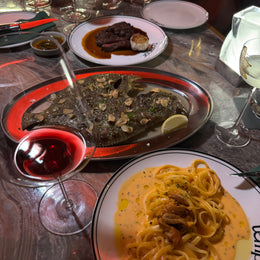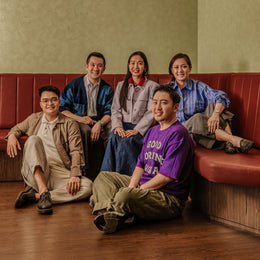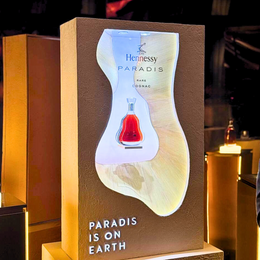Welcome to part two of Keeping Up with the Kagoshimas, wherein our intrepid shochu investigator and solo traveller @vernoncelli tours Kagoshima and uncovers the history of shochu.In part one of our series, we talked about how sweet potatoes and distillation arrived in Japan, with most sources saying it got it start from the Ryukyu Islands and Kagoshima.Now, while we talk about the contemporary history of imo shochu, let’s introduce to Bar Ishizue and sister bar Bar Roku, Kagoshima’s pit stops to learning about the local shochu. The bar sits at the nightlife hub of Kagoshima, within the shopping arcade of Tenmonkan.

The billboard – saying Honkaku Shochu Bar Ishizue, on the 4th Floor.
Here on out, I’ll be weaving in more imo shochu (sweet potato shochu) trivia, with courtesy of the knowledgeable bartenders that have explained much of these to me.
The bar’s full name is Honkaku Shochu Bar Ishizue. Honkaku Shochu refers to a category of shochu which uses traditional methods of distillation. The bar is dimly lit, cosy, and at first glance you think you’ve stumbled upon one of Japan’s many whisky bars. From the entrance, what caught my eye was a shochu still placed right at the side of the bar – it’s bigger than the photo would suggest.

A wooden shochu still.

The bar was also back-lit with a huge map of Kagoshima – slightly peculiar for a bar I might add!
Attending to me for most of the night at Bar Ishizue was Yohei Shimoda. At first, they asked me what kind of shochus do I like – fruity? Sweeter? More aromatic? Instead, I stated my intentions – I’m here to try out some of Komasa Jyozo’s shochus before my visit to Kanosuke Distillery next noon, and after enquiring about my experience with imo shochus (which I had barely any of), they dove into pulling a shot of their recommended liquid.

The entire line-up of Komasa shochus that the bar stocks – with Kanosuke whiskies as well.
Sparing no time at all, Shimoda got into explaining to me the ongoing Kagoshima imo shochu scene.
Apparently, compared to other prefectures, the people from Kagoshima consume the most shochu – and by a long shot (almost double of Miyazaki at 2nd place, according to these statistics). A local himself, he states that Kagoshima palates are strong in flavour and aroma, and they need something equal in strength to chase it down with. By my own anecdotal experience, I have to agree. There’s no shortage of fried foods, pork cutlets and unagi, and it’s no wonder imo shochu is called the “lifeblood” of Kagoshima.

There are 113 shochu distilleries in Kagoshima., inclusive of the southern Satsunan Islands: under the prefecture’s administration. This map is from Bar Ishizue, backlit.
With the exception of Miyazaki that produces a wide range of shochu from their base spirits (including soba, or buckwheat – the same sort used in buckwheat noodles), most prefectures in Kyushu have a favourite base ingredient to work with. Typically, the base ingredient that grows best in the region will naturally be the favourite to work (and drink) with. For Kumamoto, that’ll be rice shochu, or kome shochu. For Kagoshima’s case, it’s sweet potatoes.

A sweet potato farm in Kagoshima. Source: Senganen
For most of the 113 distilleries in Kagoshima, their shochu rarely spread outside their locality. This is largely in part that shochu is produced in small quantities, and hence there are shochus where they are only available at certain towns within their proximity. In order to get some shochus from specific distilleries, you’ve got to travel down and buy them yourself from a local liquor shop. Also, as using sweet potatoes from farms in other towns is relatively common, some imo shochus in Kagoshima are only made from produce from a specific area, and example being a Sakurajima-only imo shochu.

I got this sample of Sakurajima Sotsu from a convenience store just in front of the island’s jetty, run by a lovely bunch of old folks. Sakurajima is a volcanic peninsula off the coast of Kagoshima city.
So here’s how Bar Ishizue differentiates its shochu collection from other bars. The owner, Yuichi Ikehata, wanted to show Kagoshima locals, Japanese from other prefectures and guests abroad, that shochu is not just a cheap and simple way to get your booze fix. He wanted to show that Kagoshima shochus are complex, sophisticated, and full of character – worthy of exploring. Hence, in 2008, he opened Bar Ishizue, right in the heart of Kagoshima city.

Bar Ishizue. Source: Kagoshima City Tourism Guide
Ikehata and his staff drive around Kagoshima to liquor stores, sampling and bringing back a few bottles to stock in his bar. Much of the shochu bottles in Bar Ishizue come in 1.8 litres, a standard of shochu bottle size similar to sakes and wines. There are close to 1500 different bottles of shochu in their inventory, alongside other natively produced tipples such as whiskies, craft gins and liqueurs. According to the Kagoshima Shochu Maker’s Association, there’s over 2000 brands of shochu made in Kagoshima.

Bar Owner Yuichi Ikehata. Source: Honkaku Shochu
Here, Shimoda explained to me the map of Kagoshima and showing me where Komasa Jyozo is at.

Sipping on the Komasa “The Green”. Komasa Jyozo 小正醸造 is relatively near to Kagoshima city 鹿児島市, as compared to other distilleries.
While shochus are mostly made from sweet potatoes in Kagoshima, there are always exceptions to the rule. For instance, the Komasa shochu distillery started out using rice to make shochu for shrine offerings, and is best known for their legendary Kozuru barrel aged shochu. The southern islands use sugarcane instead, one of the more common base ingredients in other parts of Japan such as Okinawa.

Satsuma Shochu Label. Source: Satsuma Shuzo
There are a few indicators that shows that your shochu’s origin and quality, such as the Satsuma Shochu, usually near the neck of the bottle. It depicts a traditional kettle for heating up shochu. This label assures three things: 1) sweet potatoes and water must come from Kagoshima, 2) rice or imo koji must be used, 3) the shochu must be processed, distilled and bottled in Kagoshima. There are other labels that indicate quality and origin for Kagoshima imo shochus, but this has been the one I seen the most by my own experience.
I was ushered back to my seat for more shochu tastings, and upon returning, I was greeted with a small sample entrée. The dishes, prepared by the chef Teruaki Nakashima, is further proof of how Kagoshimans really like their food strong in flavour. From right to left: crispy sweet potato crackers, slices of smoked duck breast, and local premium pork mixed with miso and topped with a quail egg. I think my favourite pairing was the smoked duck breast and the shochus – something about oily, smoky fat being washed down with a slightly fiery liquid that is so satisfying.

My 1st set of drinking snacks for the night.
Joining Shimoda was Takashi Yamaguchi, whom recommended my 2nd shochu for the night, alongside filling me in with the specifics of each shochu. Just like most great alcohols in the world, there’s differences between sweet potatoes – the ones that you eat and the ones you ferment. For instance, table grapes which are a lot plumper and juicier differ from wine grapes, which are smaller, rounder, and have a much higher concentration of sugar.
In Kagoshima, the opposite is true: a favourite and widely eaten varietal of sweet potato called “Annou 安納” is prized for its high glucose content and sweet flavour, while the sweet potatoes used for brewing and shochu are a lot starchier in comparison, like “Kogane-Sengan 黄金千貫“. (Note that there are shochus being made with Annou sweet potatoes as well.)

Annou Imo vs Kogane-Sengan Imo, a popular varietal for shochu making. Source: Japopo
After a few shochu tastings with Bar Ishizue, I was recommended and escorted by Shimoda to check out the sister bar, Bar Roku, just a few minutes’ walk away from Bar Ishizue.

*Note that this billboard is old and has since changed.
There, I was greeted by Maya Aley, the sole bartender at Bar Roku for the night.

In our precursor article, Maya’s blogs were extremely helpful. Please give them a read!
Here on out, Maya warmly introduced me to Bar Roku, conversing in English (I had a mental lag moment codeswitching from Japanese to English, which needed some warming up). While not having as big of an inventory of Kagoshima shochu as Bar Ishizue, Bar Roku had a respectable 400 different bottles of the local stuff, plus a few whiskies outside of Kagoshima prefecture.

Bar Roku, from the entrance.
Bar Roku resembled more like a typical small-space Japanese bar – outfitted with quaint wooden furniture, dimly lit and cosy. After having what was essentially a crash course on Kagoshima shochus, a change of scenery was a needed one. Upon being seated, I was promptly served with more otsumami (drinking snacks): sweet potato crisps, caramel almonds and miso paste on roasted seaweed.

My 2nd set of otsumami.
As much as I loved the samples of shochus, I wanted something a little different to end the night. I informed Maya about my itinerary next noon, and she whipped up a cocktail right on the spot: the Komasa Special. Note that the exact ingredients weren’t measured and it was the on-the-fly moment, so if you ever order this at Bar Roku, it might be a bit different!

The Komasa Special: Komasa Ichigoshu, Komasa Ichigo Gin, Komasa Mellowed Kozuru. I asked for a drink heavier on the booze – and this one surely delivered.
And here concludes my bar escapades at Bar Ishizue and Bar Roku! If you’re looking to visit the two bars, here are some things to note.
The staff at Bar Ishizue do not speak English. As much as possible, they will converse with you in English and use a translation software to get the meanings across, which I am hugely grateful for (after all, my Japanese is far from fluent). If you do not converse in Japanese, visiting Bar Roku is a great alternative, as Maya speaks both English and Japanese.
Additionally, Bar Roku is slated to move to a bigger venue in July 2023 – so if you’re planning a trip to Kagoshima, do note about the change in address.

Once again, I am extremely grateful for the hospitality I received from Bar Ishizue and Bar Roku. I’ll definitely be visiting again if I’m ever at Kagoshima! Now, to end off the trilogy of this series, we’ll be reviewing a few shochus, sprinkled in yet again more trivia. Stay tuned!
P.S. If you’re visiting Bar Ishizue and Bar Roku, tell them 88 Bamboo sent you!
UPDATE: Bar Roku has since moved and changed its location and name, to Kagoshima Shochu Bar Roku. The addresses below are the most updated.
Honkaku Shochu Bar Ishizue @bar.ishizue
天文館フラワービル 4F, 6-1 Sennichicho, Kagoshima, 892-0843, Japan

@vernoncelli







